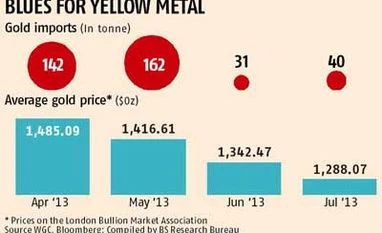As gold imports were contributing significantly to the country’s current account deficit, there were all-round efforts by the government and the Reserve Bank of India (RBI) to curb it, which led to a sharp fall in imports in June and July.
A large chunk of these 40 tonnes entered India in the first three weeks of the month. On July 22, the Reserve Bank of India (RBI) issued a new policy, which linked gold imports with exports, and put restrictions on consignment import. This had created confusion on the procedural aspect of implementing the new norms, and imports came virtually on halt.
In April and May 2013, India imported 304 tonnes of gold, which had triggered several restriction on imports. However in June, imports fell to around $2 billion, while in July, at an average price of $1,288 per ounce, the imports bill is estimated to be around $1.65 billion. In July 2012, imports were 65 tonnes and at an average gold price of $1,594, the imports bill stood at $3.3 billion.
Gold demand is likely to improve as the festive season is near. However, if imports remain restricted due to policy issues, the shortage of gold will only aggravate. Since the last couple of months, even gold jewellery exports have been badly affected by the shortage of gold.
The sector is expecting the central bank to soon clarify its policy on gold imports and jewellers are also awaiting its resumption of gold as hundreds of thousands of artisans are out of work until gold was not available.
ALSO READ: More steps to reduce CAD soon, says Rajan
Gold was trading at a Rs 500 premium to the landed cost on Thursday. This is due to some bear operators have been trapped in the futures market and prices went up. They are willing to give delivery of gold but that is not available in the physical market and, hence, ready to pay huge premiums for the delivery.
)